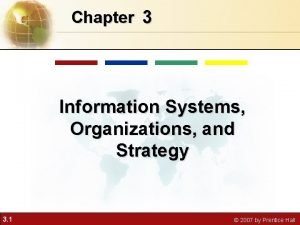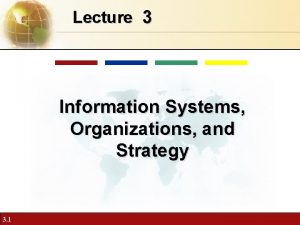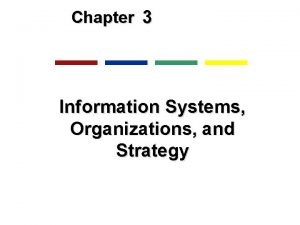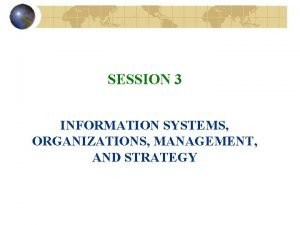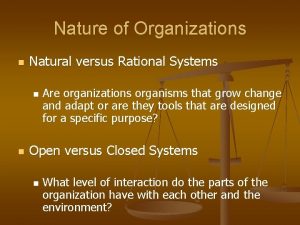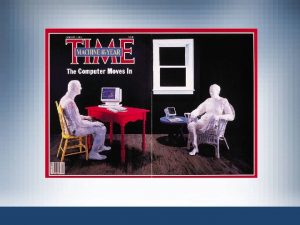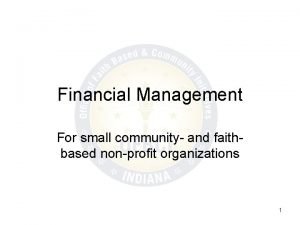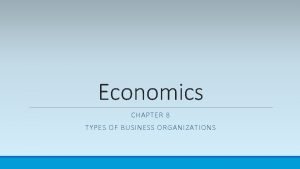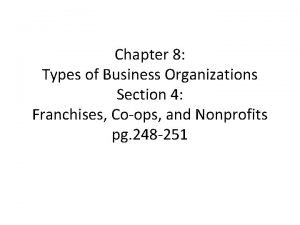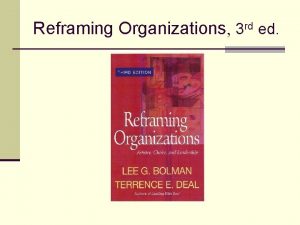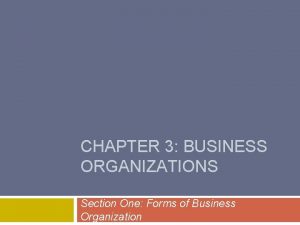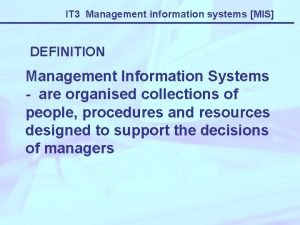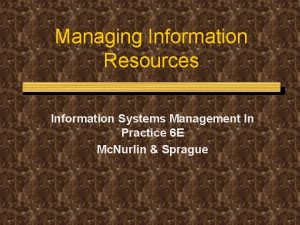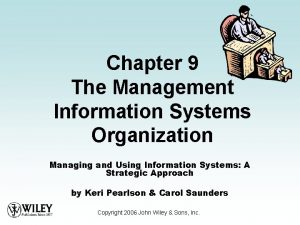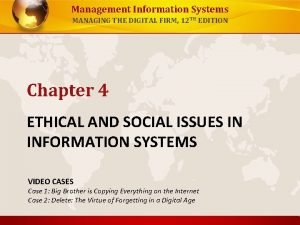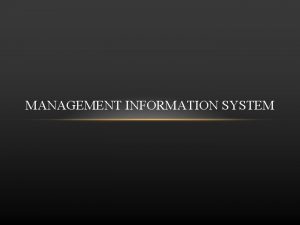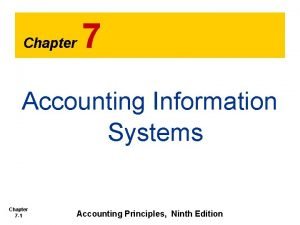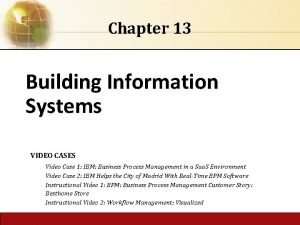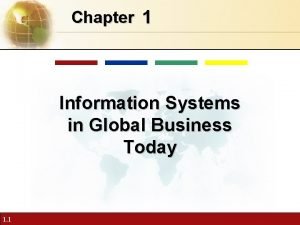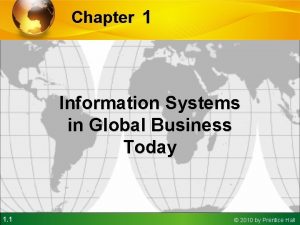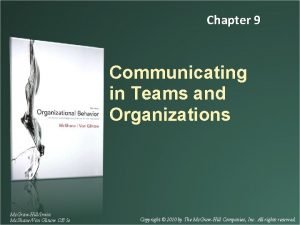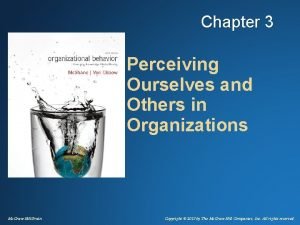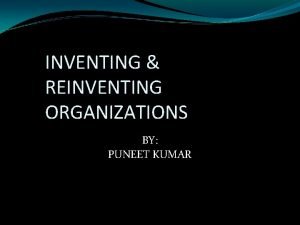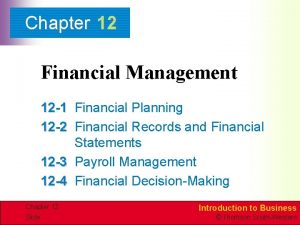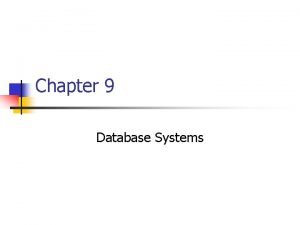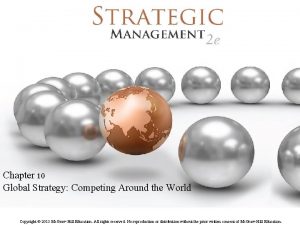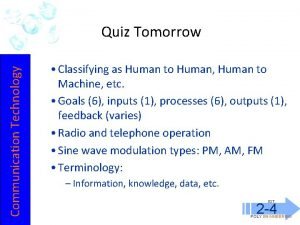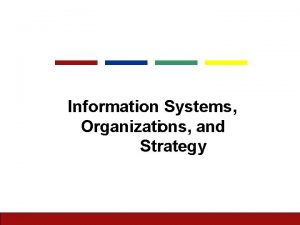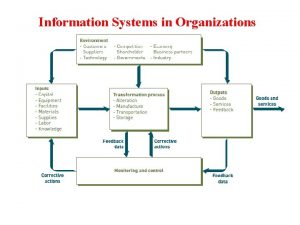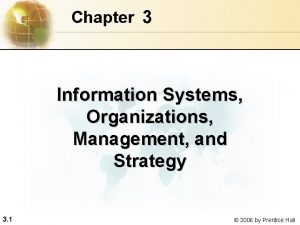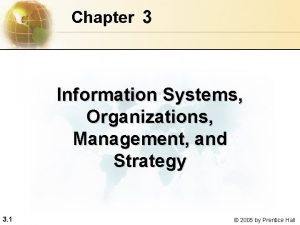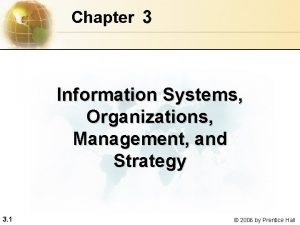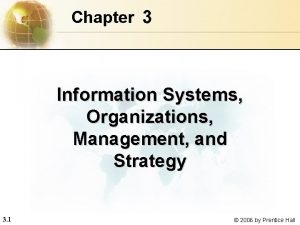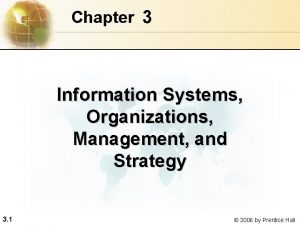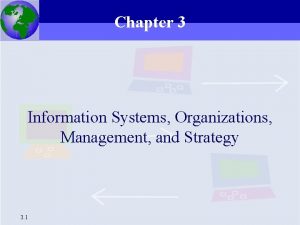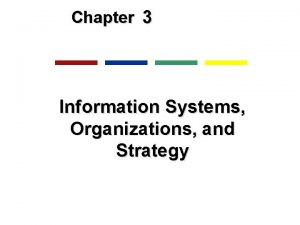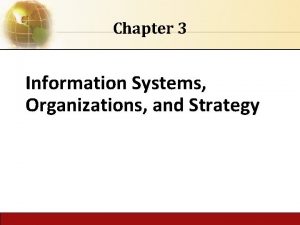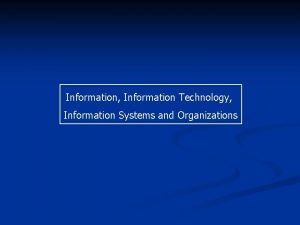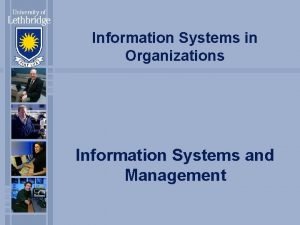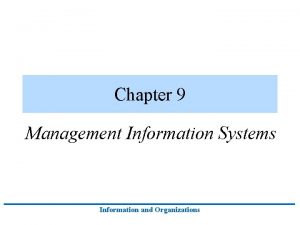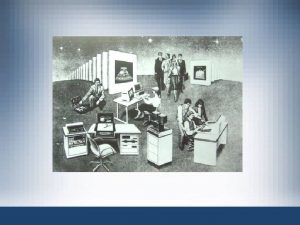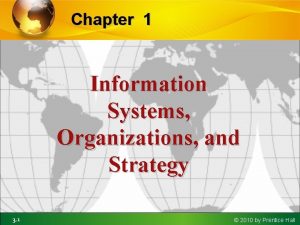Chapter 3 Information Systems Organizations Management and Strategy













































































- Slides: 77

Chapter 3 Information Systems, Organizations, Management, and Strategy 3. 1 © 2006 by Prentice Hall

Management Information Systems Chapter 3 Information Systems, Organizations, Management, and Strategy OBJECTIVES 3. 2 • Identify and describe important features of organizations that managers need to know about in order to build and use information systems successfully • Evaluate the impact of information systems on organizations • Assess how information systems support the activities of managers in organizations © 2006 by Prentice Hall

Management Information Systems Chapter 3 Information Systems, Organizations, Management, and Strategy OBJECTIVES (Continued) • Analyze how information systems support various business strategies for competitive advantage • Assess the challenges posed by strategic information systems and management solutions 3. 3 © 2006 by Prentice Hall

Management Information Systems Chapter 3 Information Systems, Organizations, Management, and Strategy Gallo Winery Case • Challenge: powerful competitors, price conscious consumers. Manage 95 brands of wine • Solutions. Warehouse management system: coordinates production, suppliers, inventory and shipment • Shortens order-to-door cycle by 10 days • Gallo Edge analyzes profitability by bottle for customers like Albertsons and Wal-Mart. • Gallo Wine Manager system analyzes price vs. taste relationship. • Demonstrates the interdependence of business environments, management, culture, and strategy 3. 4 © 2006 by Prentice Hall

Management Information Systems Chapter 3 Information Systems, Organizations, Management, and Strategy ORGANIZATIONS AND INFORMATION SYSTEMS The Two-Way Relationship between Organizations and Information Technology 3. 5 Figure 3 -1 © 2006 by Prentice Hall

Management Information Systems Chapter 3 Information Systems, Organizations, Management, and Strategy ORGANIZATIONS AND INFORMATION SYSTEMS What Is an Organization? Organization: • Stable, formal social structure • Takes resources from the environment and processes them to produce outputs 3. 6 © 2006 by Prentice Hall

Management Information Systems Chapter 3 Information Systems, Organizations, Management, and Strategy ORGANIZATIONS AND INFORMATION SYSTEMS The Technical Microeconomic Definition of the Organization 3. 7 Figure 3 -2 © 2006 by Prentice Hall

Management Information Systems Chapter 3 Information Systems, Organizations, Management, and Strategy ORGANIZATIONS AND INFORMATION SYSTEMS Behavioral Definition of Organization: • Collection of rights, privileges, obligations, and responsibilities • Delicately balanced over a period of time through conflict • Conflict resolution 3. 8 © 2006 by Prentice Hall

Management Information Systems Chapter 3 Information Systems, Organizations, Management, and Strategy ORGANIZATIONS AND INFORMATION SYSTEMS The Behavioral View of Organizations 3. 9 Figure 3 -3 © 2006 by Prentice Hall

Management Information Systems Chapter 3 Information Systems, Organizations, Management, and Strategy ORGANIZATIONS AND INFORMATION SYSTEMS Common Features of Organizations • All organizations have some similar “structural” features. 3. 10 © 2006 by Prentice Hall

Management Information Systems Chapter 3 Information Systems, Organizations, Management, and Strategy ORGANIZATIONS AND INFORMATION SYSTEMS Shared Features of all Organizations: • Clear division of labor • Hierarchy • Explicit rules and procedures • Impartial judgments Table 3 -1 3. 11 © 2006 by Prentice Hall

Management Information Systems Chapter 3 Information Systems, Organizations, Management, and Strategy ORGANIZATIONS AND INFORMATION SYSTEMS Shared Features of all Organizations: (Continued) • Technical qualifications for positions • Maximum organizational efficiency Table 3 -1 (Continued) 3. 12 © 2006 by Prentice Hall

Management Information Systems Chapter 3 Information Systems, Organizations, Management, and Strategy ORGANIZATIONS AND INFORMATION SYSTEMS Routines and Business Processes • Routines are patterns of individual behavior. • Business processes are a collection of routines. • Business firms are a collection of business processes. • Business processes enable organizations to cope with all recurring expected situations. 3. 13 © 2006 by Prentice Hall

Management Information Systems Chapter 3 Information Systems, Organizations, Management, and Strategy ORGANIZATIONS AND INFORMATION SYSTEMS Routines, Business Processes, and Firms 3. 14 Figure 3 -4 © 2006 by Prentice Hall

Management Information Systems Chapter 3 Information Systems, Organizations, Management, and Strategy ORGANIZATIONS AND INFORMATION SYSTEMS Organizational Politics • Divergent viewpoints lead to political struggle, competition, and conflict. • Hamper organizational change 3. 15 © 2006 by Prentice Hall

Management Information Systems Chapter 3 Information Systems, Organizations, Management, and Strategy ORGANIZATIONS AND INFORMATION SYSTEMS Organizational Culture • What products the organization should produce • How and where it should be produced • For whom the products should be produced 3. 16 © 2006 by Prentice Hall

Management Information Systems Chapter 3 Information Systems, Organizations, Management, and Strategy ORGANIZATIONS AND INFORMATION SYSTEMS Unique Features of Organizations • Structures • Goals • Constituencies • Leadership styles • Tasks • Surrounding environments 3. 17 © 2006 by Prentice Hall

Management Information Systems Chapter 3 Information Systems, Organizations, Management, and Strategy ORGANIZATIONS AND INFORMATION SYSTEMS Organizational Structures • Entrepreneurial structure: Small start-up business • Machine bureaucracy: Midsize manufacturing firm • Divisionalized bureaucracy: Fortune 500 firms • Professional bureaucracy: Law firms, school systems, hospitals • Adhocracy: Consulting firms 3. 18 © 2006 by Prentice Hall

Management Information Systems Chapter 3 Information Systems, Organizations, Management, and Strategy ORGANIZATIONS AND INFORMATION SYSTEMS Organizations and Environments: • Organizations and environments have a reciprocal relationship. • Organizations are open to, and dependent on, the social and physical environment. • Organizations can influence their environments. 3. 19 © 2006 by Prentice Hall

Management Information Systems Chapter 3 Information Systems, Organizations, Management, and Strategy ORGANIZATIONS AND INFORMATION SYSTEMS Environments and Organizations Have a Reciprocal Relationship 3. 20 Figure 3 -5 © 2006 by Prentice Hall

Management Information Systems Chapter 3 Information Systems, Organizations, Management, and Strategy ORGANIZATIONS AND INFORMATION SYSTEMS Other Differences Among Organizations: • Ultimate goals • Different groups and constituencies • Nature of leadership • Tasks and technology 3. 21 © 2006 by Prentice Hall

Management Information Systems Chapter 3 Information Systems, Organizations, Management, and Strategy ORGANIZATIONS AND INFORMATION SYSTEMS Organizing the IT Function The information systems department is responsible for maintaining: • Hardware • Software • Data storage • Networks 3. 22 © 2006 by Prentice Hall

Management Information Systems Chapter 3 Information Systems, Organizations, Management, and Strategy ORGANIZATIONS AND INFORMATION SYSTEMS Information Technology Services 3. 23 Figure 3 -6 © 2006 by Prentice Hall

Management Information Systems Chapter 3 Information Systems, Organizations, Management, and Strategy ORGANIZATIONS AND INFORMATION SYSTEMS Includes Specialists: • Programmers: Highly trained, writers of the software instructions for computers • Systems analysts: Translate business problems into solutions, act as liaisons between the information systems department and rest of the organization • Information system managers: Leaders of various specialists 3. 24 © 2006 by Prentice Hall

Management Information Systems Chapter 3 Information Systems, Organizations, Management, and Strategy ORGANIZATIONS AND INFORMATION SYSTEMS Includes Specialists: (Continued) • Chief Information Officer (CIO): Senior manager in charge of information systems function in the firm • End users: Department representatives outside the information system department for whom applications are developed 3. 25 © 2006 by Prentice Hall

Management Information Systems Chapter 3 Information Systems, Organizations, Management, and Strategy HOW INFORMATION SYSTEMS IMPACT ORGANIZATIONS AND BUSINESS FIRMS Economic Impacts: • IT changes both the relative costs of capital and the costs of information. • Information systems technology is a factor of production, like capital and labor. 3. 26 © 2006 by Prentice Hall

Management Information Systems Chapter 3 Information Systems, Organizations, Management, and Strategy HOW INFORMATION SYSTEMS IMPACT ORGANIZATIONS AND BUSINESS FIRMS Economic Impacts: (Continued) • Transaction cost theory: Firms seek to economize on the cost of participating in markets (transaction costs). • IT lowers market transaction costs for firm, making it worthwhile for firms to transact with other firms rather than grow the number of employees 3. 27 © 2006 by Prentice Hall

Management Information Systems Chapter 3 Information Systems, Organizations, Management, and Strategy HOW INFORMATION SYSTEMS IMPACT ORGANIZATIONS AND BUSINESS FIRMS The Transaction Cost Theory of the Impact of Information Technology on the Organization Figure 3 -7 3. 28 © 2006 by Prentice Hall

Management Information Systems Chapter 3 Information Systems, Organizations, Management, and Strategy HOW INFORMATION SYSTEMS IMPACT ORGANIZATIONS AND BUSINESS FIRMS • Agency theory: Firm is nexus of contracts among self-interested parties requiring supervision. • Firms experience agency costs (the cost of managing and supervising). • IT can reduce agency costs, making it possible for firms to grow without adding to the costs of supervising, and without adding employees. 3. 29 © 2006 by Prentice Hall

Management Information Systems Chapter 3 Information Systems, Organizations, Management, and Strategy HOW INFORMATION SYSTEMS IMPACT ORGANIZATIONS AND BUSINESS FIRMS The Agency Cost Theory of the Impact of Information Technology on the Organization 3. 30 Figure 3 -8 © 2006 by Prentice Hall

Management Information Systems Chapter 3 Information Systems, Organizations, Management, and Strategy HOW INFORMATION SYSTEMS IMPACT ORGANIZATIONS AND BUSINESS FIRMS Organizational and Behavioral Impacts IT Flattens Organizations: • Facilitates flattening of hierarchies • Broadens the distribution of timely information • Increases the speed of decision making 3. 31 © 2006 by Prentice Hall

Management Information Systems Chapter 3 Information Systems, Organizations, Management, and Strategy HOW INFORMATION SYSTEMS IMPACT ORGANIZATIONS AND BUSINESS FIRMS IT Flattens Organizations: (Continued) • Empowers lower-level employees to make decisions without supervision and increase management efficiency • Management span of control (the number of employees supervised by each manager) will also grow 3. 32 © 2006 by Prentice Hall

Management Information Systems Chapter 3 Information Systems, Organizations, Management, and Strategy HOW INFORMATION SYSTEMS IMPACT ORGANIZATIONS AND BUSINESS FIRMS Flattening Organizations 3. 33 Figure 3 -9 © 2006 by Prentice Hall

Management Information Systems Chapter 3 Information Systems, Organizations, Management, and Strategy HOW INFORMATION SYSTEMS IMPACT ORGANIZATIONS AND BUSINESS FIRMS Postindustrial Organizations and Virtual Firms Postindustrial Organizations: • Authority increasingly relies on knowledge and competence. • Information technology encourages task force-networked organizations. 3. 34 © 2006 by Prentice Hall

Management Information Systems Chapter 3 Information Systems, Organizations, Management, and Strategy HOW INFORMATION SYSTEMS IMPACT ORGANIZATIONS AND BUSINESS FIRMS Virtual Firms: • Use networks to link people, assets, and ideas • Can ally with suppliers, customers to create and distribute new products and services • Not limited to traditional organizational boundaries or physical locations 3. 35 © 2006 by Prentice Hall

Management Information Systems Chapter 3 Information Systems, Organizations, Management, and Strategy HOW INFORMATION SYSTEMS IMPACT ORGANIZATIONS AND BUSINESS FIRMS Increasing Flexibility of Organizations: • Information systems give both large and small organizations additional flexibility to overcome the limitations posed by their size. • Small organizations use information systems to acquire some of the muscle and reach of larger organizations. 3. 36 © 2006 by Prentice Hall

Management Information Systems Chapter 3 Information Systems, Organizations, Management, and Strategy HOW INFORMATION SYSTEMS IMPACT ORGANIZATIONS AND BUSINESS FIRMS Increasing Flexibility of Organizations: (Continued) • Large organizations use information technology to achieve some of the agility and responsiveness of small organizations. • Customization and personalization: IT makes it possible to tailor products and services to individuals. 3. 37 © 2006 by Prentice Hall

Management Information Systems Chapter 3 Information Systems, Organizations, Management, and Strategy HOW INFORMATION SYSTEMS IMPACT ORGANIZATIONS AND BUSINESS FIRMS Understanding Organizational Resistance to Change: • Information systems become bound up in organizational politics because they influence access to a key resource. • Information systems potentially change an organization’s structure, culture, politics, and work. • Most common reason for failure of large projects is due to organizational and political resistance to change. 3. 38 © 2006 by Prentice Hall

Management Information Systems Chapter 3 Information Systems, Organizations, Management, and Strategy HOW INFORMATION SYSTEMS IMPACT ORGANIZATIONS AND BUSINESS FIRMS Organizational Resistance and the Mutually Adjusting Relationship between Technology and the Organization Source: Reprinted by permission of James G. March. 3. 39 Figure 3 -10 © 2006 by Prentice Hall

Management Information Systems Chapter 3 Information Systems, Organizations, Management, and Strategy HOW INFORMATION SYSTEMS IMPACT ORGANIZATIONS AND BUSINESS FIRMS The Internet and Organizations • The Internet increases the accessibility, storage, distribution of information and knowledge for business firms. • The Internet lowers the transaction and agency costs of firms. • Businesses are rapidly rebuilding their key business processes based on Internet technology. Example: online order entry, customer service, and fulfillment of orders. 3. 40 © 2006 by Prentice Hall

Management Information Systems Chapter 3 Information Systems, Organizations, Management, and Strategy THE IMPACT OF IT ON MANAGEMENT DECISION MAKING The Role of Managers in Organizations Classical Descriptions of Management: • Traditional description of management • Focuses on formal functions: Plan, organize, coordinate, decide, control 3. 41 © 2006 by Prentice Hall

Management Information Systems Chapter 3 Information Systems, Organizations, Management, and Strategy THE IMPACT OF IT ON MANAGEMENT DECISION MAKING Behavioral Models: • Describes management based on observations of what managers actually do on the job Managerial Roles: • Expectation of activities that managers should perform in an organization 3. 42 © 2006 by Prentice Hall

Management Information Systems Chapter 3 Information Systems, Organizations, Management, and Strategy THE IMPACT OF IT ON MANAGEMENT DECISION MAKING Management Roles: • Interpersonal: Managers act as figureheads and leaders. • Informational: Managers receive and disseminate critical information, nerve centers. • Decisional: Managers initiate activities, allocate resources, and negotiate conflicts. 3. 43 © 2006 by Prentice Hall

Management Information Systems Chapter 3 Information Systems, Organizations, Management, and Strategy THE IMPACT OF IT ON MANAGEMENT DECISION MAKING Models of Decision Making • Rational model: An individual manager identifies A goals, ranks all possible alternative actions and chooses the alternative that contributes most to those goals • Organizational model: Considers the structural C and political characteristics of an organization • Bureaucratic model: Whatever organizations do is the result of routines and existing business processes honed over years of active use 3. 44 © 2006 by Prentice Hall

Management Information Systems Chapter 3 Information Systems, Organizations, Management, and Strategy THE IMPACT OF IT ON MANAGEMENT DECISION MAKING Models of Decision Making (Continued) • Political model: What an organization does is a result of political bargains struck among key leaders and interest groups 3. 45 © 2006 by Prentice Hall

Management Information Systems Chapter 3 Information Systems, Organizations, Management, and Strategy THE IMPACT OF IT ON MANAGEMENT DECISION MAKING Implications for the Design and Understanding of Information Systems Factors to consider while planning a new system: • Organizational environment • Organizational structure, hierarchy, specialization, routines, and business processes • The organization’s culture and politics 3. 46 © 2006 by Prentice Hall

Management Information Systems Chapter 3 Information Systems, Organizations, Management, and Strategy THE IMPACT OF IT ON MANAGEMENT DECISION MAKING Implications for the Design and Understanding of Information Systems (Continued) • The type of organization and its style of leadership • Groups affected by the system and the attitudes of workers who will be using the system • The kinds of tasks, decisions, and business processes that the information system is designed to assist 3. 47 © 2006 by Prentice Hall

Management Information Systems Chapter 3 Information Systems, Organizations, Management, and Strategy THE IMPACT OF IT ON MANAGEMENT DECISION MAKING Characteristics to be kept in mind while Designing Systems: • Flexibility and multiple options for handling data and evaluating information • Capability to support a variety of management styles, management skills, and knowledge 3. 48 © 2006 by Prentice Hall

Management Information Systems Chapter 3 Information Systems, Organizations, Management, and Strategy THE IMPACT OF IT ON MANAGEMENT DECISION MAKING Characteristics to be kept in mind while Designing Systems: (Continued) • Capability to keep track of many alternatives and consequences • Sensitivity to the organization’s bureaucratic and political requirements 3. 49 © 2006 by Prentice Hall

Management Information Systems Chapter 3 Information Systems, Organizations, Management, and Strategy INFORMATION SYSTEMS AND BUSINESS STRATEGY Business strategy decisions of the firms will determine the following: • The products and services a firm produces • The industries in which the firm competes • Competitors, suppliers, and customers of the firm • Long-term goals of the firm 3. 50 © 2006 by Prentice Hall

Management Information Systems Chapter 3 Information Systems, Organizations, Management, and Strategy INFORMATION SYSTEMS AND BUSINESS STRATEGY Business-Level Strategy: The Value Chain Model The most common generic business level strategies are: • Become the low-cost producer • Differentiate your product from competitors’ products • Change the scope of competition by enlarging the market or narrowing it to a specialized niche 3. 51 © 2006 by Prentice Hall

Management Information Systems Chapter 3 Information Systems, Organizations, Management, and Strategy INFORMATION SYSTEMS AND BUSINESS STRATEGY Value Chain Model: • Highlights the primary or support activities that add business value • A good tool for understanding strategy at the business firm level Primary Activities: • Directly related to the production and distribution of a firm’s products or services 3. 52 © 2006 by Prentice Hall

Management Information Systems Chapter 3 Information Systems, Organizations, Management, and Strategy INFORMATION SYSTEMS AND BUSINESS STRATEGY Support Activities: • Make the delivery of primary activities possible • Consist of the organization’s infrastructure, human resources, technology, and procurement 3. 53 © 2006 by Prentice Hall

Management Information Systems Chapter 3 Information Systems, Organizations, Management, and Strategy INFORMATION SYSTEMS AND BUSINESS STRATEGY The Firm Value Chain and the Industry Value Chain 3. 54 Figure 3 -11 © 2006 by Prentice Hall

Management Information Systems Chapter 3 Information Systems, Organizations, Management, and Strategy INFORMATION SYSTEMS AND BUSINESS STRATEGY Strategic question: • How can IT be used at each point in the value chain to lower costs, differentiate products, and change the scope of competition? 3. 55 © 2006 by Prentice Hall

Management Information Systems Chapter 3 Information Systems, Organizations, Management, and Strategy INFORMATION SYSTEMS AND BUSINESS STRATEGY Value Web: Internet-enabled Web of cooperating firms • Customer-driven network of independent firms • Uses information technology to coordinate value chains of separate firms for collectively producing a chains of separate firms product or service 3. 56 © 2006 by Prentice Hall

Management Information Systems Chapter 3 Information Systems, Organizations, Management, and Strategy INFORMATION SYSTEMS AND BUSINESS STRATEGY The Value Web 3. 57 Figure 3 -12 © 2006 by Prentice Hall

Management Information Systems Chapter 3 Information Systems, Organizations, Management, and Strategy INFORMATION SYSTEMS AND BUSINESS STRATEGY Information Systems Products and Services Systems that Create Product Differentiation: • Firms can use IT to develop differentiated products. • Create brand loyalty by developing new and unique products and services • Product and services not easily duplicated by competitors Examples: Dell, Orbitz 3. 58 © 2006 by Prentice Hall

Management Information Systems Chapter 3 Information Systems, Organizations, Management, and Strategy INFORMATION SYSTEMS AND BUSINESS STRATEGY Systems that Support Focused Differentiation: • Uses intensive analysis of customer data to support new ways of contacting and serving the customer • Enables development of new market niches for specialized products or services Example: Wyndam Hotels frequent guest program 3. 59 © 2006 by Prentice Hall

Management Information Systems Chapter 3 Information Systems, Organizations, Management, and Strategy INFORMATION SYSTEMS AND BUSINESS STRATEGY Supply Chain Management and Efficient Customer Response Systems: Response Systems • Link your firm’s value chain to the value chains of your suppliers and customers • Directly links consumer behavior back to distribution, production, and supply chains • Example: Wal-Mart directly links customer purchases to suppliers in nearly real time. It is the suppliers’ job to ensure products are shipped to the store to replace purchased products 3. 60 © 2006 by Prentice Hall

Management Information Systems Chapter 3 Information Systems, Organizations, Management, and Strategy INFORMATION SYSTEMS AND BUSINESS STRATEGY Switching Costs and Lock-in Effects • IT is used at the firm level to discourage customers from switching to other suppliers, and “locking” them into a firm’s channels. • Switching cost is the expense incurred by a customer or company for changing from one supplier or system to another. • Example: Baxter International 3. 61 © 2006 by Prentice Hall

Management Information Systems Chapter 3 Information Systems, Organizations, Management, and Strategy INFORMATION SYSTEMS AND BUSINESS STRATEGY Stockless Inventory compared to Traditional and Justin-time Supply Methods 3. 62 Figure 3 -13 © 2006 by Prentice Hall

Management Information Systems Chapter 3 Information Systems, Organizations, Management, and Strategy INFORMATION SYSTEMS AND BUSINESS STRATEGY Business-level Strategy 3. 63 Figure 3 -14 © 2006 by Prentice Hall

Management Information Systems Chapter 3 Information Systems, Organizations, Management, and Strategy INFORMATION SYSTEMS AND BUSINESS STRATEGY Firm-Level Strategy and Information Technology Core Competency: • Activity at which a firm excels as a world-class leader • Information systems encourage the sharing of knowledge across business units and therefore enhance firm competency 3. 64 © 2006 by Prentice Hall

Management Information Systems Chapter 3 Information Systems, Organizations, Management, and Strategy INFORMATION SYSTEMS AND BUSINESS STRATEGY Industry-Level Strategy and Information Systems: Competitive Forces and Network Economics Firms operate in a larger environment composed of other firms, governments, and nations Information partnership: • Cooperative alliance formed between two or more corporations for sharing information to gain strategic advantage • Help firms gain access to new customers, creating new opportunities for cross-selling and targeting products 3. 65 © 2006 by Prentice Hall

Management Information Systems Chapter 3 Information Systems, Organizations, Management, and Strategy INFORMATION SYSTEMS AND BUSINESS STRATEGY Porter’s Five Forces Model In the larger environment, there are five main forces or threats: • New market entrants • Substitute products and services • Suppliers • Customers • Other firms competing directly 3. 66 © 2006 by Prentice Hall

Management Information Systems Chapter 3 Information Systems, Organizations, Management, and Strategy INFORMATION SYSTEMS AND BUSINESS STRATEGY Porter’s Competitive Forces Model 3. 67 Figure 3 -15 © 2006 by Prentice Hall

Management Information Systems Chapter 3 Information Systems, Organizations, Management, and Strategy INFORMATION SYSTEMS AND BUSINESS STRATEGY IT and the Internet can greatly change the strength of these competitive forces: • Encourage new entrants. Example: Net. Flix vs. Blockbuster • Increase customer bargaining power. Example: Expedia. com and others 3. 68 © 2006 by Prentice Hall

Management Information Systems Chapter 3 Information Systems, Organizations, Management, and Strategy INFORMATION SYSTEMS AND BUSINESS STRATEGY IT and the Internet can greatly change the strength of these competitive forces: (Continued) • Decrease in supplier power. Example: e. Campus. com increases the efficiency of used textbook market, reducing publisher profits • Substitute products. Example: online music lowers value of record stores 3. 69 © 2006 by Prentice Hall

Management Information Systems Chapter 3 Information Systems, Organizations, Management, and Strategy INFORMATION SYSTEMS AND BUSINESS STRATEGY Business Ecosystems: IT plays a powerful role in creating new forms of business ecosystems. • Business ecosystems are interdependent networks of suppliers, distributors, outsourcing firms, transportation service firms, and technology manufacturers. 3. 70 © 2006 by Prentice Hall

Management Information Systems Chapter 3 Information Systems, Organizations, Management, and Strategy INFORMATION SYSTEMS AND BUSINESS STRATEGY Examples: • Microsoft: 1 billion PCs worldwide and hundreds of thousands of businesses rely on Microsoft’s platform. • EBay: Millions of people and thousands of business firms use this platform. • Wal-Mart: Enterprise systems used by suppliers to increase their efficiency 3. 71 © 2006 by Prentice Hall

Management Information Systems Chapter 3 Information Systems, Organizations, Management, and Strategy INFORMATION SYSTEMS AND BUSINESS STRATEGY An Ecosystem Strategic Model 3. 72 Figure 3 -16 © 2006 by Prentice Hall

Management Information Systems Chapter 3 Information Systems, Organizations, Management, and Strategy INFORMATION SYSTEMS AND BUSINESS STRATEGY Network Economics: • IT products and services exhibit powerful network effects and create potential “winner take all” situations. • Network effects occur when adding more resources to a process incurs little or zero cost, but large gains in output. • Contrary to the law of diminishing returns typical of industrial and agricultural products 3. 73 © 2006 by Prentice Hall

Management Information Systems Chapter 3 Information Systems, Organizations, Management, and Strategy INFORMATION SYSTEMS AND BUSINESS STRATEGY Network Economics: (Continued) • Example: Value of the Internet grows exponentially with the linear increase in users. • Example: Because certain software can become a standard (like Windows operating systems or Windows Office), people can get locked into that standard and the value of Windows grows as more and more people use it. • Good strategy: Use IT to build products and services that exhibit network effects. 3. 74 © 2006 by Prentice Hall

Management Information Systems Chapter 3 Information Systems, Organizations, Management, and Strategy MANAGEMENT OPPORTUNITIES, CHALLENGES AND SOLUTIONS Management Opportunities: • Firms face a continuing stream of IT-based opportunities to achieve strategic advantages 3. 75 © 2006 by Prentice Hall

Management Information Systems Chapter 3 Information Systems, Organizations, Management, and Strategy MANAGEMENT OPPORTUNITIES, CHALLENGES AND SOLUTIONS Management Challenges: • Some firms face big hurdles in implementing contemporary systems. • Once an advantage is achieved, there are difficulties in sustaining the advantage. • Organizations often cannot change fast enough to accommodate new technologies. 3. 76 © 2006 by Prentice Hall

Management Information Systems Chapter 3 Information Systems, Organizations, Management, and Strategy MANAGEMENT OPPORTUNITIES, CHALLENGES AND SOLUTIONS Solution Guidelines: Perform a strategic systems analysis • Understand the structure and competitive dynamics of the industry where your firm operates • Understand the business, firm, and industry value chains • Consider how your firm can manage “strategic transitions” as it seeks to implement systems that provide competitive advantages 3. 77 © 2006 by Prentice Hall
 Chapter 3 information systems organizations and strategy
Chapter 3 information systems organizations and strategy Information systems organizations and strategy
Information systems organizations and strategy Information systems, organizations, and strategy
Information systems, organizations, and strategy Information systems, organizations, and strategy
Information systems, organizations, and strategy Information systems organizations and strategy
Information systems organizations and strategy Introduction to management chapter 1
Introduction to management chapter 1 Management information system chapter 1
Management information system chapter 1 Introduction of management information system
Introduction of management information system Natural system organization
Natural system organization Information systems strategy triangle example
Information systems strategy triangle example Information systems strategy matrix example
Information systems strategy matrix example Information
Information Chapter 4 ethical and social issues in information systems
Chapter 4 ethical and social issues in information systems 4 components of an information system
4 components of an information system Financial management software for faith-based organizations
Financial management software for faith-based organizations Management in criminal justice organizations
Management in criminal justice organizations Chapter 8 types of business organizations
Chapter 8 types of business organizations Section 4 other organizations
Section 4 other organizations Chapter 8 section 4 other organizations
Chapter 8 section 4 other organizations Reframing organizations chapter 3 summary
Reframing organizations chapter 3 summary Chapter 3 business organizations
Chapter 3 business organizations Mis information system
Mis information system Mis manager meaning
Mis manager meaning Information systems management in practice
Information systems management in practice Vertical
Vertical Management information systems wiley
Management information systems wiley The time/space collaboration and social tool matrix
The time/space collaboration and social tool matrix Management information systems effy oz
Management information systems effy oz Introduction to information systems 5th edition
Introduction to information systems 5th edition Management information systems managing the digital firm
Management information systems managing the digital firm A marketing information system mis consists of
A marketing information system mis consists of Securing information systems
Securing information systems Chapter 8 securing information systems
Chapter 8 securing information systems Chapter 7 accounting information systems
Chapter 7 accounting information systems Chapter 7 accounting information systems
Chapter 7 accounting information systems Dfd ch 13
Dfd ch 13 Securing information systems
Securing information systems Introduction to information systems 6th edition
Introduction to information systems 6th edition Fundamentals of information system
Fundamentals of information system Challenges of global information systems
Challenges of global information systems Chapter 8 securing information systems
Chapter 8 securing information systems Information systems in global business today
Information systems in global business today Chapter 8 securing information systems
Chapter 8 securing information systems Chapter 7 accounting information systems
Chapter 7 accounting information systems Information systems in global business today
Information systems in global business today Business strategy vs corporate strategy
Business strategy vs corporate strategy Production plan example
Production plan example Chapter 9 information management and security
Chapter 9 information management and security Chapter 15 using management and accounting information
Chapter 15 using management and accounting information Power and politics in organizations
Power and politics in organizations Voluntary health and welfare organization examples
Voluntary health and welfare organization examples Floral shops bookstores and farms are examples of
Floral shops bookstores and farms are examples of Formal groups fulfill both and functions in organizations.
Formal groups fulfill both and functions in organizations. Communicating in teams and organizations
Communicating in teams and organizations Power politics and conflict in organizations
Power politics and conflict in organizations Perceiving ourselves and others in organizations
Perceiving ourselves and others in organizations Csusm clubs and organizations
Csusm clubs and organizations Conflict power and politics
Conflict power and politics Mangalore chemicals and fertilizers parent organizations
Mangalore chemicals and fertilizers parent organizations Inventing and reinventing organizations
Inventing and reinventing organizations Cultures and organizations software of the mind
Cultures and organizations software of the mind Social groups and formal organizations
Social groups and formal organizations Chapter 12 financial management
Chapter 12 financial management Decision support systems and intelligent systems
Decision support systems and intelligent systems Active managerial control software
Active managerial control software Chapter 9 database management systems
Chapter 9 database management systems Global matrix structure
Global matrix structure Transnational strategy vs global strategy
Transnational strategy vs global strategy Aligning hr strategy with business strategy
Aligning hr strategy with business strategy Integration responsiveness grid
Integration responsiveness grid Strategy executing process
Strategy executing process Strategy formulation vs strategy implementation
Strategy formulation vs strategy implementation Listening strategies activities
Listening strategies activities Strategy formulation corporate strategy
Strategy formulation corporate strategy International or multinational
International or multinational Managing and using information systems
Managing and using information systems Key technology trends that raise ethical issues
Key technology trends that raise ethical issues Information systems and communication technologies quiz
Information systems and communication technologies quiz

